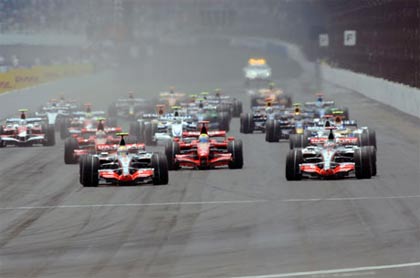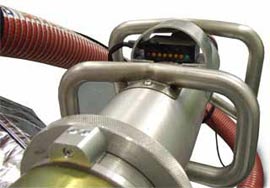What is the gasoline of other F1 petrol cars?
Formula 1 cars use their own fuel for engines. Most of the teams are fuel-free because the technical partners are the world's leading manufacturers.
Fuel, specifically gasoline, is a liquid that is mixed with air in the engine cylinder to create combustion, and to power the engine. Better fuel should be evenly distributed in the combustion chamber and burnt partially on every 3 centimeters, the capacity will be generated more with a constant amount of fuel, or more fuel-efficient.
It would be easy without restrictions. The Federation of International Sports Cars (FIA - Fédération Internationale de "Automobile) has limited the value of octane, oxygen and nitrogen index and the proportion of fuel. Fuel of F1 vehicles must not contain compounds. not in commercial gasoline, these requirements are based on the decision of the European Parliament for commercial gasoline production since 2000. Thanks to mathematical models to predict the capacity and limit properties of gasoline, one Fuel types that may be ready to increase capacity for vehicles will be available in the FIA's limit order.

Formula 1 racing is a place to showcase and test leading technologies
History
Back in the founding years of Formula 1, the fuel mixture was mixed by chemists. They made these mixtures from substances like benzene, methanol, acetone and nitrobenzene, which were drained out of the engine immediately after tests or racing. Without these precautions, the engine will be broken after only one night. Later, kerosene was used until the end of the 60s, before the list of added substances was further narrowed by the FIA, to protect riders and mechanics.
 By the end of the 70s, new adjustments allowed the use of high octane gasoline, sold in France, Italy, Germany and the UK. RON 101 gasoline has been sold on gas stations in Europe, with permissible tolerances up to RON 102. When this type of gasoline is not allowed to be sold anymore, suppliers have been allowed to prepare a special gas. for F1 racing cars. Therefore, becoming a more complex gasoline and different from conventional commercial gasoline.
By the end of the 70s, new adjustments allowed the use of high octane gasoline, sold in France, Italy, Germany and the UK. RON 101 gasoline has been sold on gas stations in Europe, with permissible tolerances up to RON 102. When this type of gasoline is not allowed to be sold anymore, suppliers have been allowed to prepare a special gas. for F1 racing cars. Therefore, becoming a more complex gasoline and different from conventional commercial gasoline.
By the end of the 80s, RON 102 gasoline continued to be restricted, and limited to both oxygen and nitrogen content (less than 2%). Subsequently, new restrictions were issued, such as vapor pressure, density, benzene and lead content, which were also added. Oil companies also tested more than 300 mixes until the early 1990s.
In 1992, the FIA decided it would be illegal to use any substance in fuel that was not found in commercial gasoline. Since 1993, only unleaded " super " gasoline that conforms to European standards is accepted, similar types of gasoline are also available at gas stations in many parts of the world.

Riders compete for every second so fuel is one of the most important factors
Manufacturing
Production begins with the goal of obtaining the most power from the engine that can and does not take into account the durability and focus on fuel savings.
The first stage is to use a computer model to predict, the data is taken from more than 100 raw materials to obtain experimental gasoline. Studies to give the best fuel mix and high power to decide every second for racing, c
 Evil engineers can mix and burn virtual gasoline, without a real production process. Some teams have developed their computer technology, so virtual gasoline can be tested on a virtual engine. These mathematical models were used for Formula 1 engines with a wide variety of fuels and properties of raw materials.
Evil engineers can mix and burn virtual gasoline, without a real production process. Some teams have developed their computer technology, so virtual gasoline can be tested on a virtual engine. These mathematical models were used for Formula 1 engines with a wide variety of fuels and properties of raw materials.
The second stage is to prepare a small portion of different fuels and test them in the simulation to determine if they meet the standards, and then be tested with the engine to measure power and pepper. pass. After selecting a few samples, it is possible to succeed with the motors, the tested engine is on the test strip and on the test track. Once the gasoline mixture is determined, a sample is sent to the FIA lab in the UK for certification.
With lubricants, oil companies produced batches, with Elf they produced each batch in the amount of 40 m3 at Elf's Solaize research center and were transported in several 50-liter barrels.
A top team needs about 3,600 liters of fuel and 200 liters of engine oil, 180 liters of gearbox oil, 80 liters of hydraulic oil, 20 liters of cooling oil and kilos of fat per race. There is always an oil engineer representative at each stage for 5 days to check first if all the fuel has been brought to adjust chromatography and spectroscopy to allow analysis and diagnosis. engine. At the end of the race, all unused oil is returned to the manufacturer.

Blending gasoline mixture in the laboratory
Structure
As mentioned above, Formula 1 racing fuel has the same composition as other commercial gasoline types. It's just different from the ratio of the components that make up the gasoline. Due to limitations, the amount of hydrocarbons can be classified into two main categories:

And testing
+ Hydrocarbon: In this case, the molecule contains enough hydrogen atoms
Paraffin (straight chain, simple link): High molecular weight alkaline hydrocarbon with a general chemical formula of C n H 2n + 2 , where n is between 22 and 27.
Naphthenic (loop with simple bonding): Has extremely low temperature properties, mainly used for lubrication.
+ Non-saturated hydrocarbons: molecules do not contain enough hydrocarbon atoms.
Aromatic (loop, with double bonds and other simple links, that is benzene nucleus): they are called aromatic hydrocarbons. The main components of aromatic are benzene, tuoluene and xylene.
Diolefin or Diene (straight circuit with double bond)
Acetylene (straight circuit with triple bond): Acetylene is part of alkyne

Gasoline often

Gasoline for F1 cars
Tank
F1 cars use a fuel tank that can be made from Kevlar material. This type of fuel tank is reduced
 Maximum danger in the event of an accident. The fuel tank will deform itself at the pressure set area. All fuel lines will automatically shut down to prevent fuel lines from being cracked. There is also a fire extinguisher in the sensitive area of the vehicle that will automatically open when a collision occurs.
Maximum danger in the event of an accident. The fuel tank will deform itself at the pressure set area. All fuel lines will automatically shut down to prevent fuel lines from being cracked. There is also a fire extinguisher in the sensitive area of the vehicle that will automatically open when a collision occurs.
The size of the fuel tank is also quite important for chassis designs. The size of the fuel tank can affect the fuel consumption of the vehicle, the average length restriction, the dynamics . Therefore, the fuel tank is placed directly under the driver's seat, it occupies the space determined between the driver car and engine.
Recent Formula 1 racing cars, fuel consumption can range from 180 to 200 liters in over 300 km of track. Racers can adjust a little bit of this number depending on their driving style or driving under conditions that do not prioritize operation like running a safety car.
Fuel loading
 Since 1994, refueling at pit stop returns to Formula 1 racing races, bringing excitement to the audience to witness the race. The teams always have three people to refuel the car. The first person called 'hoseman' often takes him into the car and pulls it out when there's enough fuel for the car. A second member holds the fuel hose in the right position behind the hoseman to help propel the fuel hose quickly when the fuel injection process ends, a third person helps to avoid the heat from the exhaust from the refuelers, only do safety work.
Since 1994, refueling at pit stop returns to Formula 1 racing races, bringing excitement to the audience to witness the race. The teams always have three people to refuel the car. The first person called 'hoseman' often takes him into the car and pulls it out when there's enough fuel for the car. A second member holds the fuel hose in the right position behind the hoseman to help propel the fuel hose quickly when the fuel injection process ends, a third person helps to avoid the heat from the exhaust from the refuelers, only do safety work.
Since a vehicle may have to be fueled at a rate of 11 liters / second, there was a lot of skepticism about safety in 1994. However in the following years, fuel napping was again accepted in F1. and is an integral part of the pit stop. Accidents occurred during those years, but to keep them as safe as possible, the FIA asked a French company to create the desired settings of each team. Each team must pay 30,000 Euro. Whenever problems occur, fuel lines will be cut automatically to minimize fire safety hazards.
However, operation is a problem, now, teams use non-metallic materials to avoid heating up the fuel. The lower the temperature, the higher the density, thus generating more power with each equal amount of fuel injection in the cylinder. Fuel is usually kept around 10 o C.

Refuel at Pit Stop

An accident occurred during refueling
Long Thanh
- Australia: List of series of cars and motorcycles not suitable for E5 gasoline
- What is the benefit of E5 petrol - 'A replacement'?
- Netherlands introduces gasoline pumping robot
- In the early morning, the density of gasoline is more dense, so should we refuel in the morning?
- Petrol mixed with ethanol is similar to regular gasoline
- Electric cars are more polluting than gasoline vehicles
- Hazards when using must be fake petrol, poor quality
- 5 tips to avoid being
- Things to know about E5 gasoline
- Homemade petrol, priced below VND 8,000 / liter ... A new invention?
- Producing gasoline directly from scrap
- Students who make cars can run nearly 3,000 km with a liter of gasoline
 'Barefoot engineer' invents a pipeless pump
'Barefoot engineer' invents a pipeless pump Process of handling dead pigs due to disease
Process of handling dead pigs due to disease Radiometer
Radiometer Warp Engine: Technology brings us closer to the speed of light
Warp Engine: Technology brings us closer to the speed of light